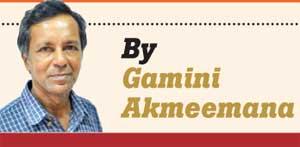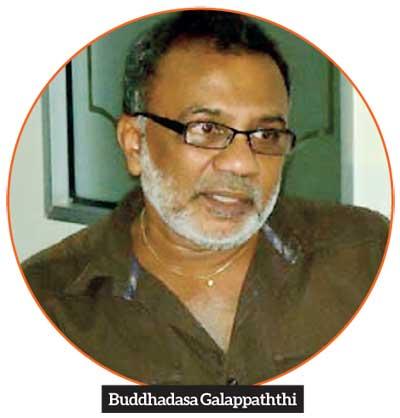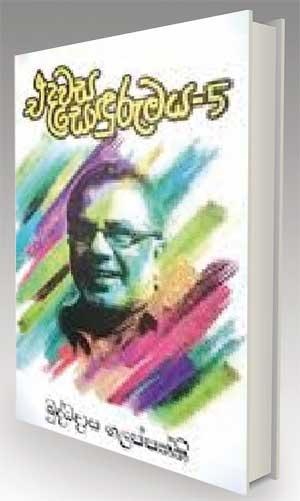25 Feb 2019 - {{hitsCtrl.values.hits}}
Buddhi’s handy handbook to Lankan culture and arts
A restless mind delving into every corner, dark and bright of Sri Lankan culture and social life
 uddhadasa Galappaththi (Buddhi) in his incarnation as a journalist has a prodigious output. The fifth book in his Edawasa Sondurumaya series based on his newspaper columns is now available as an author publication.
uddhadasa Galappaththi (Buddhi) in his incarnation as a journalist has a prodigious output. The fifth book in his Edawasa Sondurumaya series based on his newspaper columns is now available as an author publication.
The 41 chapters in this 262-page book carry the hallmark of Buddhi’s journalism.
His mind ranges far and wide, touching not just the famous but those lesser known and those who had fallen into obscurity with the passage of time. That’s his speciality, showing not just his dedication to his craft but a deep love of the arts and those who are driven to create something new.
In this collection, his subjects range from the top of the pyramid, with names such as W. D. Amaradeva, Parakrama Kodituwakku and Wijeratne Warakagoda, to schoolteacher Thilini Nadeeka Shelwin and dramatist Bandula Jeyawardene, and a story totally unrelated to the arts, that of a police sergeant who committed suicide.
Buddhi sees no point in the endless moralising and fault finding, an FB trademark nowadays
The 41 chapters in this 262-page book carry the hallmark of Buddhi’s journalism
The generation gap witnesses rapid changes, both physically and in memory. Old streets, buildings and landmarks are razed along with their memory associations. Erasures of memory  are equally sweeping. For those who haven’t heard of novelist Karunasena Jayalath or even teledrama scriptwriter Somaweera Senanayake, Buddhi evokes two bygone eras splendidly in his usual manner – beginning with the novel Golu Hadawatha (Sri Lanka’s Love Story) and then moving on to the celebrated movie by Dr Lester James Pieris.
are equally sweeping. For those who haven’t heard of novelist Karunasena Jayalath or even teledrama scriptwriter Somaweera Senanayake, Buddhi evokes two bygone eras splendidly in his usual manner – beginning with the novel Golu Hadawatha (Sri Lanka’s Love Story) and then moving on to the celebrated movie by Dr Lester James Pieris.
Not stopping there, he gives us the real-life background and people who prompted Karunasena Jayalath to write what still remains as the best-known romance in Sinhala fiction. The author further reveals that proof of the real-life love triangle behind the fiction is given in the book Hendewata Payana Hiru by D. B. Kuruppu.
Not stopping with this fascinating story, he provides an anecdote about the short-sighted decision taken by directors of Ceylon Theatres (Producers of the movie version) to cut the movie by 12 minutes, a disaster prevented only by the intervention of Dr Bernard Zoysa.
"A criticism of the state music awards festival leads to recollections of Sinhala film songs of the 1960s-70s, memories of H. R. Jothipala, Angelene Gunathilake, Milton Mallawarachi and Clarence Wijewardhane along with Gamini Fonseka, Malani Fonseka, Robin Fernando, Nita Fernando and Gita Kumarasinghe"
In typical fashion, he then talks about the poignant musical score by Dr Premasiri Khemadasa, which undoubtedly contributed to the movie’s box office success.
That chapter actually ends with serious criticism of those self-styled Facebook ‘experts’ who love to air opinions on everything under the sun, and a major error committed by one of them after the death of the real-life Damayanthi who inspired Karunasena Jayalath.
 In the chapter titled Looking for Yasodhara’s Chastity, the author again attacks the Facebook know-alls.
In the chapter titled Looking for Yasodhara’s Chastity, the author again attacks the Facebook know-alls.
Buddhi sees no point in the endless moralising and fault finding, an FB trademark nowadays.
For example, he is vexed by those who asked why Lester James Pieris was cremated after his death as he wasn’t a Buddhist!
This is a very good example of the inane hair-splitting which characterizes so much of FB ‘discussions.’
A criticism of the state music awards festival leads to recollections of Sinhala film songs of the 1960s-70s, memories of H. R. Jothipala, Angelene Gunathilake, Milton Mallawarachi and Clarence Wijewardhane along with Gamini Fonseka, Malani Fonseka, Robin Fernando, Nita Fernando and Githa Kumarasinghe.
Among contemporary singers, he writes about Mihindu Ariyaratne. He’s made a name for himself in the still fledgeling sphere of Sinhala rock music. In typical fashion, the author changes the subject and moves on to the village of Palugolla in the Kurunegala district, among the poorest in Sri Lanka. A venture by a team of volunteers to gift books and stationery to the village school.
Noticing the worn shoes of these school children, the group decided to buy them new shoes. They were able to raise the Rs. 300,000 necessary to buy 344 pairs of new shoes in three months.
"Other chapters include one about Judge Manikkawasagar Ilanchelian from Jaffna, for whom the death of one of his police bodyguards became a highly emotional, watershed moment, and the anti-Muslim riots of 2018"
Buddhi’s chapter on dramatist Sugathapala de Silva is a compressed encyclopaedia.
Reading it, we learn that it’s actor W. Jayasiri who offered his hard-earned money from a Middle East job to produce Marat Sade, a milestone in the Sinhala theatre.
The author traces Sugathapala de Silva’s evolution as a dramatist from ‘Boding Karayo’ (1962) and the revolution brought about by his style in the Sinhala theatre and proceeds to introduce the dramatist’s lesser-known role as a writer for radio.
Other chapters include one about Judge Manikkawasagar Ilanchelian from Jaffna, for whom the death of one of his police bodyguards became a highly emotional, watershed moment, and the anti-Muslim riots of 2018. This is a restless mind delving into every corner, both dark and bright, of Sri Lankan culture and social life, and this is a book which should not be missed.

22 Dec 2024 5 hours ago
22 Dec 2024 5 hours ago
22 Dec 2024 7 hours ago
22 Dec 2024 8 hours ago
22 Dec 2024 8 hours ago